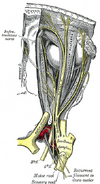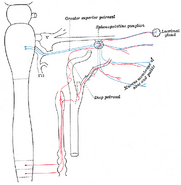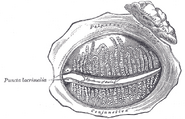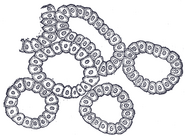Assessment |
Biopsychology |
Comparative |
Cognitive |
Developmental |
Language |
Individual differences |
Personality |
Philosophy |
Social |
Methods |
Statistics |
Clinical |
Educational |
Industrial |
Professional items |
World psychology |
Biological: Behavioural genetics · Evolutionary psychology · Neuroanatomy · Neurochemistry · Neuroendocrinology · Neuroscience · Psychoneuroimmunology · Physiological Psychology · Psychopharmacology (Index, Outline)
| Lacrimal glands | ||
|---|---|---|
| Lacrimal apparatus of the right eye. The lacrimal gland is to the upper right. The right side of the picture is towards the nose. | ||
| Latin | glandula lacrimalis | |
| Gray's | subject #227 1028 | |
| System | ||
| MeSH | [1] | |
| Tear system. a = lacrimal gland b = superior lacrimal punctum c = superior lacrimal canal d = lacrimal sac e = inferior lacrimal punctum f = inferior lacrimal canal g = nasolacrimal canal | ||
The lacrimal glands are paired glands, one for each eye, that secrete the aqueous layer of the tear film.
Anatomy[]
Each lacrimal gland is divided into orbital and palpebral portions by the aponeurosis of the Levator palpebrae superioris muscle, the portions are continuous with each other.
- The orbital portion is the largest of the portions, and its convex superior surface is lodged in the lacrimal fossa of the orbit.
- For the smaller palpebral portion, its inferior surface lies close to the eye; if the upper eyelid is everted, the palpebral portion can be seen.
The orbital portion contains fine interlobular ducts that unite to form 3 - 5 main excretory ducts, joining 5 - 7 ducts in the palpebral portion before the secreted fluid may enter on the surface of the eye.
Structure[]
The lacrimal gland is a tubuloacinar gland, it is made up of many lobules separated by connection tissue, each lobule contains many acini.
Each acini is a tubuloacinar unit, and they consist of a mass of cells with their apices pointed to a central lumen.
The central lumen of many of the units united to form intralobular ducts, and then unite to form interlobular ducts.
Innervation[]
The sensory innervation to the lacrimal gland is from the lacrimal nerve of the trigeminal nerve.
The parasympathetic nerve supply originates from the lacrimal nucleus of the facial nerve in the pons. Just before reaching the geniculate ganglion, the facial nerve gives-off a branch the greater petrosal nerve. This nerve carries the parasympathetic secretomotor fibers thorugh the pterygoid canal to the pterygopalatine ganglion. Here the fibers synapse and postganglionic fibers join the inferior orbital nerve, which travels thorugh the inferior orbital fissure. Once it has traversed this opening, the parasympathetic secretomotr fibers join a branch of this inferior orbital nerve, namely the zygomatic nerve, part of which enters the lacrimal galdn to supply it with secretomotion.
The sympathetic postganglionic fibres originates from the superior cervical ganglion. The travel as a periarteriolar plexus with the middle meningeal artery, before they merge and form the deep petrosal nerve, which joins the greater petrosal nerve in the pterygoid canal. Together, greater petrosal and deep petrosal nerves form the [[nerve of the pterygoid canal] (vidian nerve) and reach the pterygopalatine galnglion in the pterygopalatine fossa. In contrast to their parasympathetic counterparts, sympathetic fibers do not synpase. However they join the parasympathetic fibers, hence from this point on the routes of the parasympathetic and sympahteitc fibers for the lacrimal gland are the same (inferior orbital nerve -> inferior orbital fissure -> zygomatic nerver -> lacrimal gland).
Blood supply[]
The lacrimal artery, derived from the ophthalmic artery supplies the lacrimal gland.
Pathology[]
- Dacryoadenitis
- Sjögren's Syndrome
Additional images[]
See also[]
External links[]
Accessory organs of the eye | |
|---|---|
| General |
Eyebrow - Eyelid - Canthus - Eyelash - Ciliary glands - Orbital septum - Plica semilunaris - Meibomian gland |
| Lacrimal apparatus |
Lacrimal lake - Lacrimal gland - Lacrimal canaliculi - Lacrimal punctum - Lacrimal papilla - Nasolacrimal duct |
| This page uses Creative Commons Licensed content from Wikipedia (view authors). |





